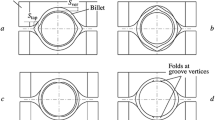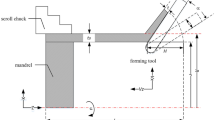Abstract
The finite element method (FEM) is used for simulation of the tube piercing process in Mannesmann mill. The numerical model is described with taking into consideration thermal phenomena in metal during forming. The simulated results visualize dynamic distributions of mean stresses, temperature, velocity and shear stresses, especially inside the workpiece. On the basis of the basic parameters, the phenomenon in the piercing process is analyzed. The model is verified by comparing the values of calculated force parameters of the piercing process and those measured in laboratory conditions.
Similar content being viewed by others
References
Fleischer M. Auslegung ausgewählter schmiedeprozesse mit hilfe der FEM [D]. Aachen: Maschinenbau College, 1996.
Sinczak J, Mahta J, Glowacki M, et al. Prediction of mechanical properties of heavy forgings [J]. Journal of Materials Processing Technology, 1998, 80–81: 166–173.
Urba’nski S, Kazanecki J. Assessment of the strain distribution in the rotary piercing process by the finite element method [J]. Journal of Materials Processing Technology, 1994, 45(1–4): 335–340.
Yoshinura H, Mihara Y, Mori K. Simplified 3D FE simulation of rotary piercing controlling rotation of plug [C]// Methods and Applications: Proceedings of the 7th International Conference on Numerical Methods in Industrial Forming Processes “Numiform 2001”. Tokyo: Tokyo University Press, 2001: 577–582.
Pietsh J, Thievien P. FEM simulation of the rotary tube piercing process [J]. Journal of Materials Processing Technology, 2003, 26(2): 52–60.
Ceretti E, Giardini C, Attanasio A, et al. Rotary tube piercing study by FEM analysis: 3D simulations and experimental results [J]. Journal of Tube & Pipe Technology, 2004, 17(2): 155–159.
Komori K. Simulation of Mannesmann piercing process by the three dimensional rigid-plastic finite-element method [J]. International Journal of Mechanical Sciences, 2005, 47(12): 1838–1853.
Pater Z, Kazanecki J, Bartnicki J. Three dimensional thermo-mechanical simulation of the tube forming process in Diescher’s mill [J]. Journal of Materials Processing Technology, 2006, 177(1–3): 167–170.
Kobayashi S, Oh S I, Altan T. Metal forming and the finite-element method [M]. New York: Oxford University Press, 1989.
MSC.Software Corporation. MSC.SuperForm user’s guide version 2005 [M]. South Coast Metro: MSC.Software Corporation Press, 2005.
Gontarz A, Łkasik K, Pater Z, et al. Technology of forming and modeling of the manufacturing process of screw spikes [M]. Lublin: Lublin University of Technology Press, 2003.
Lu Yu-qiu, Wang Xian-jin. The fracture mechanism of the centre metal during piercing in Mannesmann piercer and the technological essentials of the piercing process [J]. Iron and Steel, 1980, 15(6): 7–15 (in Chinese).
Author information
Authors and Affiliations
Corresponding author
Additional information
Foundation item: the Tianjin Natural Science Foundation (Nos. 06YFJMJC02200 and 11JCZDJC22600)
Rights and permissions
About this article
Cite this article
Lu, L., Wang, Zx., Wang, Fz. et al. Simulation of tube forming process in mannesmann mill. J. Shanghai Jiaotong Univ. (Sci.) 16, 281–285 (2011). https://doi.org/10.1007/s12204-011-1144-1
Received:
Published:
Issue Date:
DOI: https://doi.org/10.1007/s12204-011-1144-1




